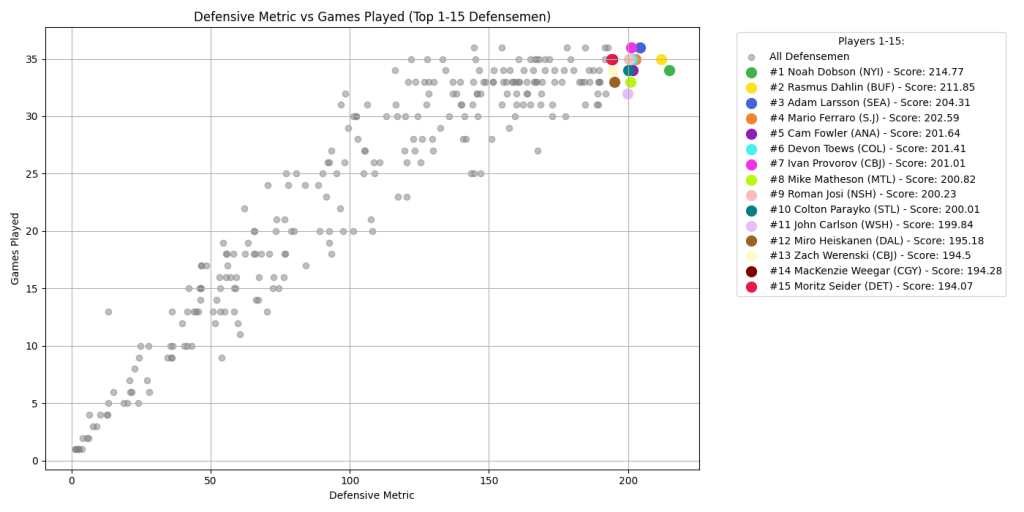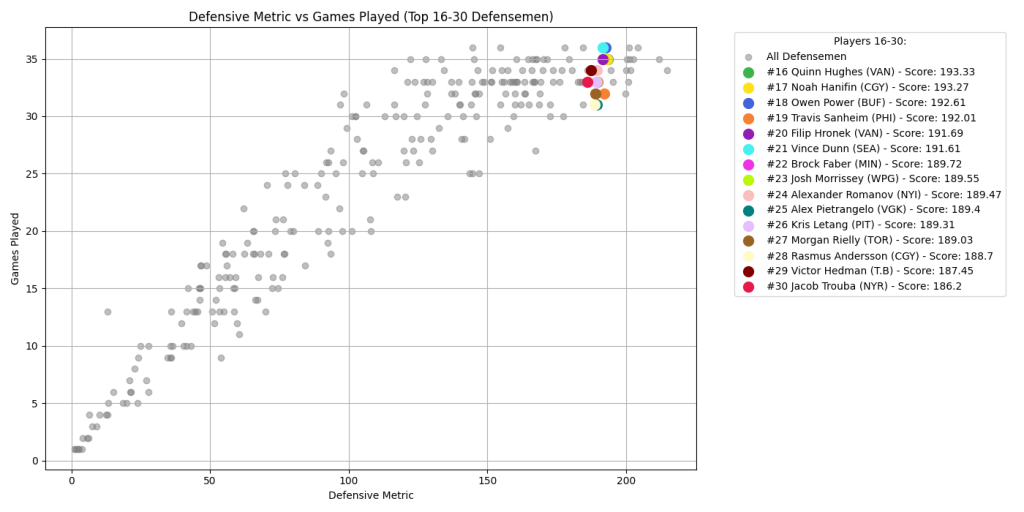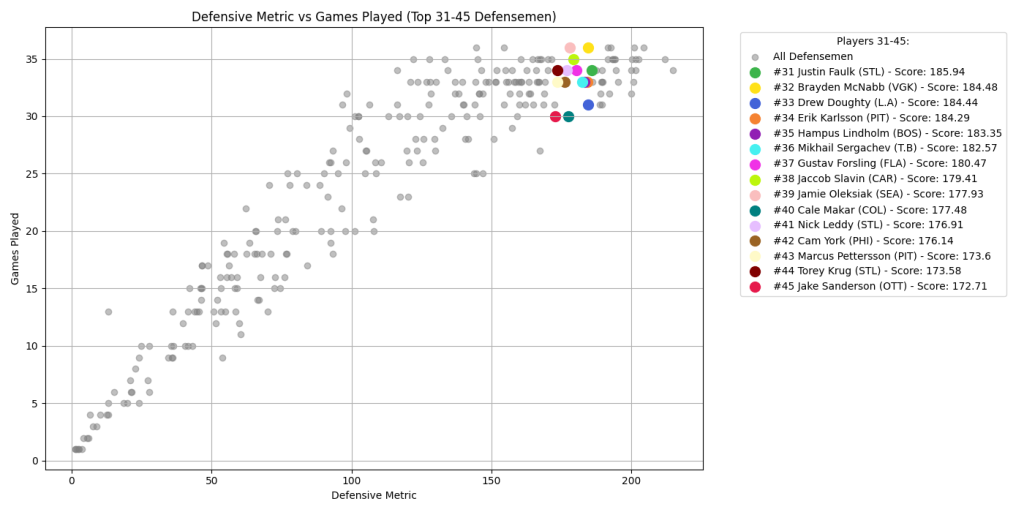Following our previous analysis of forwards, this article pivots to the vital role of defensemen in hockey. Tasked with the complex duty of safeguarding their end while setting the stage for offense, their contributions are pivotal yet often understated. We delve into the nuanced metrics that capture a defenseman’s effectiveness, providing fantasy hockey managers with a robust analytical framework. In the interplay of strategy and skill, these players emerge as the backbone of the game’s structure, their impact as significant as any celebrated goal scorer. This week, we build upon our understanding of hockey roles, turning the analytical lens towards the stoic figures patrolling the blue line, whose strategic execution is crucial in the balance of play.
The Quantifiable Impact of Defensemen
Defensemen, the strategic anchors of their teams, serve as the crucial link between a robust defense and a fluid offense. Their role, often overshadowed by the more visible scoring feats of forwards, is multifaceted and, until recently, less appreciated in the data-driven narratives of hockey. In this section, we build on the foundation laid in our previous article and turn our focus to the key metrics that encapsulate a defenseman’s impact on the game.
Defensive Composite Score: Beyond the Simple Stats
Blocked Shots (30%) – By placing their bodies in the path of high-speed pucks, defensemen not only prevent potential goals but also demonstrate a key aspect of game strategy. This metric speaks to their ability to read the game, anticipate shot trajectories, and exhibit a selfless commitment to team defense. It’s a raw measure of a player’s defensive engagement and their value in shielding the goaltender and fortifying the defensive zone.
Takeaways (30%) – A takeaway is a moment of stealthy prowess, where a defenseman reclaims possession, often halting an opponent’s scoring threat. This stat reflects a player’s agility, situational awareness, and defensive acumen. Weighted equally with blocked shots, takeaways underscore a defenseman’s capacity to transition defense into offense swiftly and effectively.
Expected Goals Against (xGA%, 20%) – The xGA% goes beyond surface-level stats to forecast a player’s impact on the team’s defensive posture. It assesses a defenseman’s positional play, stickwork, and decision-making, all of which contribute to reducing high-quality shots against. By evaluating the likelihood of goals against while a player is on the ice, xGA% provides insight into their preventive capabilities.
Time On Ice (TOI, 20%) – A defenseman’s TOI is a direct indicator of their endurance and the coaching staff’s confidence in their abilities. It’s not just about stamina; it reflects a player’s strategic importance and versatility. Defensemen with high TOI are often involved in critical situations, including power plays and penalty kills, underscoring their comprehensive role in the team’s success.
By combining these metrics into the DCS, we capture a more complete picture of a defenseman’s performance. This holistic approach transcends traditional analysis, integrating elements of sacrifice, skill, and strategic impact. It allows us to identify those defensemen who not only perform their duties but also elevate the entire team’s play. The DCS is a pivotal metric for fantasy hockey managers. It provides a robust, data-driven foundation for evaluating defensemen, guiding decisions not just by eye-catching plays, but by the indispensable, often-overlooked contributions that define the backbone of any hockey team. In the next section, we’ll visually examine the top defensemen through these analytical prisms, revealing the patterns and insights that can guide fantasy hockey managers in assembling a winning team.
Graphical Analysis



Visual data representation is key to distilling complex statistics into comprehensible insights. Through graphical analysis, we bring to light the nuances of defensive play, unveiling the true titans of the blue line. Our graphs will chart the Defensive Composite Score against games played, providing a visual comparison of the league’s top defensemen. This section will break down the graphical analysis into three distinct parts, each representing a different tier of performance.
Graph 1 – The Elite Protectors
The first graph will display the upper echelon of defensemen – the elite protectors whose scores set the standard for defensive excellence. By examining this group, we draw attention to those whose performances are not only consistent but also impactful, making them the backbone of their teams’ defensive efforts.
Graph 2 – The Ascent of the Steadfast
The second graph focuses on the middle tier – steadfast defensemen who are on the ascent, those ranked 16 to 30. These players, often on the verge of breaking into the top echelon, offer potential growth for fantasy managers looking for players with upward trajectories.
Graph 3 – The Underrated Workhorses
The final graph rounds out our analysis with the underrated workhorses, ranked 31 to 45. While they may not capture the limelight, their contributions are invaluable. This segment will highlight those whose performances are consistently solid, providing stability and depth, which can often be the difference in a fantasy hockey season.
The Defensive Composite Score, blending key metrics like blocked shots, takeaways, expected goals against, and time on ice, offers a nuanced view of defensive contributions. The graphical visualizations of these metrics underscore the varied yet pivotal impact these players have on the game. For fantasy hockey managers, this data is invaluable, providing a strategic edge in team composition. Defensemen are the unsung strategists of the sport, and acknowledging their worth is essential for a comprehensive understanding of hockey and success in fantasy leagues.
One Comment
Leave A Comment
You must be logged in to post a comment.






 UTA
UTA ANA
ANA MIN
MIN CAR
CAR MTL
MTL NYI
NYI VGK
VGK DET
DET COL
COL

Surprised mcavoy wasn’t on the